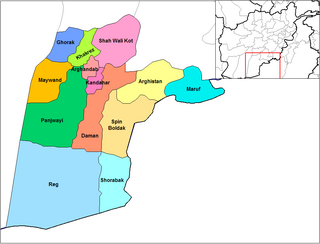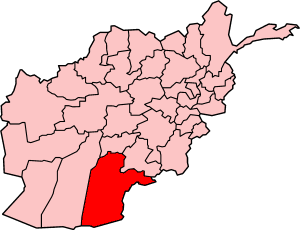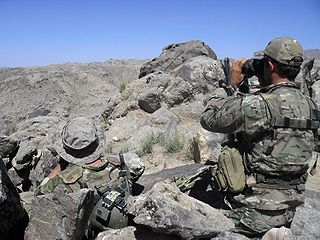In Operation Mountain Viper, the United States Army and the Afghan National Army worked together from August 30 to early September, 2003, to uncover hundreds of suspected Taliban rebels dug into the mountains of Daychopan district, Zabul province, Afghanistan.

The Royal 22nd Regiment is an infantry regiment of the Canadian Army. Known colloquially in English as the Van Doos or in French as le Vingt-deuxième, the mostly francophone regiment comprises three Regular Force battalions, two Primary Reserve battalions, and a band, making it the largest regiment in the Canadian Army. The headquarters of the regiment is at the Citadelle of Quebec in Quebec City, also the site of the regimental museum, and all three of its regular battalions are stationed at Canadian Forces Base Valcartier in Saint-Gabriel-de-Valcartier, 15 kilometres (9.3 mi) outside of Quebec City. The regiment is a "British-style" infantry regiment that is the spiritual home and repository of customs and traditions for a number of battalions that do not necessarily serve together operationally. It serves as the "local" infantry regiment for the province of Quebec, where it draws most of its recruits; it is the largest regiment in the province, in terms of numbers.

Panjwayi is a district in Kandahar Province, Afghanistan. It is located about 35 kilometres (22 mi) west of Kandahar. The district borders Helmand Province to the southwest, Maywand District to the west, Zhari District to the north, Arghandab, Kandahar and Daman districts to the east and Reg District to the south. Panjwayi was reduced in size in 2004 when Zhari District was created out of the northern part of it, on the northern side of the Arghandab River, which now forms the northern boundary.
Canada's role in the Afghanistan War began in late 2001. Canada sent its first element of soldiers secretly in October 2001 from Joint Task Force 2, and the first contingents of regular Canadian Armed Forces (CAF) troops arrived in Afghanistan in January–February 2002. The operations were aimed at identifying and neutralizing Al-Qaeda members in that country and toppling the Taliban regime which was supporting international terrorism. Canada's role in the Afghan conflict grew in 2006 when Canadian troops relieved US forces in Kandahar province, taking command of the multinational brigade in the region during a major Taliban offensive.
Operation Mountain Thrust was a NATO and Afghan-led operation in the War in Afghanistan, with more than 3,300 British troops, 2,300 U.S., 2,200 Canadian troops, about 3,500 Afghan soldiers and large air support. Its primary objective was to quell the ongoing Taliban insurgency in the south of the country.

Operation Medusa was a Canadian-led offensive during the second Battle of Panjwaii of the War in Afghanistan. The operation was fought primarily by the 1st Battalion, The Royal Canadian Regiment Battle Group and other elements of the International Security Assistance Force, supported by the Afghan National Army and a team from the United States Army's 1st Battalion, 3rd Special Forces Group (Airborne) augmented by C Company, 2nd Battalion, 87th Infantry Regiment of the 10th Mountain Division. Its goal was to establish government control over an area of Kandahar Province centered in the district of Panjwayi some 30 kilometres (19 mi) west of Kandahar city. A tactical victory, it resulted in the deaths of 12 Canadian soldiers; five during the major combat operations, five in bombings, and two in a mortar/RPG attack during the reconstruction phase of the operation. Fourteen British military personnel were also killed when their plane crashed. Despite suffering a brutal battlefield defeat, the Taliban retained their presence in Kandahar province and did not lose their will to fight, leading to the subsequent Operation Falcon Summit. Nonetheless, Operation Medusa was at the time the most significant land battle ever undertaken by NATO.

Operation Mountain Fury was a NATO-led operation begun on September 16, 2006 as a follow-up operation to Operation Medusa, to clear Taliban insurgents from the eastern provinces of Afghanistan. Another focus of the operation was to enable reconstruction projects such as schools, health-care facilities, and courthouses to take place in the targeted provinces.

The Battle of Panjwaii was fought in mid-2006 with primarily Canadian and Afghan soldiers, supported by small elements of Dutch, American, and British forces against the Taliban. There were two separate times in which the forces were involved in heavy fighting in the region. The first phase was fought in July 2006, and the second encounter lasted from September to October 2006.

Operation Falcon Summit was a Canadian-led operation in the Battle of Panjwaii and, on a larger scale, in the War in Afghanistan.

In January 2006, NATO's focus in southern Afghanistan was to form Provincial Reconstruction Teams with the British leading in Helmand Province and the Netherlands, Australia and Canada leading similar deployments in Orūzgān Province and Kandahar Province respectively. The United States, with 2,200 troops, stayed in control of Zabul Province. Local Taliban figures voiced opposition to the incoming force and pledged to resist it.

The following items form a partial timeline of the War in Afghanistan. For events prior to October 7, 2001, see 2001 in Afghanistan.

The Helmand province campaign was a series of military operations conducted by the International Security Assistance Force (ISAF) forces against Taliban insurgents and other local groups in the Helmand Province of Afghanistan. Their objective was to control a province that was known to be a Taliban stronghold, and a center of opium production. None of the ISAF's intended strategic and political objectives were achieved in the long term.

US and NATO International Security Assistance Force (ISAF) operations, alongside Afghan National Army forces, continued against the Taliban through 2007.

Operation Shahi Tandar, also called Operation Atal, was a series of operations by Coalition troops from the British 42 Commando Royal Marines, Royal Canadian Regiment, 2nd Battalion 2nd Infantry Regiment, and the Afghan national military in central Helmand province and the Western Panjwayi and Western Zhari districts of Kandahar, Afghanistan from January 7–31, 2009.
Operation Moshtarak, also known as the Battle of Marjah, was an International Security Assistance Force (ISAF) pacification offensive in the town of Marjah, Helmand Province, Afghanistan. It involved a combined total of 15,000 Afghan, American, British, Canadian, Danish, and Estonian troops, constituting the largest joint operation of the War in Afghanistan up to that point. The purpose of the operation was to remove the Taliban from Marja, thus eliminating the last Taliban stronghold in central Helmand Province. The main target of the offensive was the town of Marjah, which had been controlled for years by the Taliban as well as drug traffickers.

The Shah Wali Kot Offensive was a five-day joint operation during the War in Afghanistan, conducted by Australian special forces and the Afghan National Army with US air support, between 10 and 14 June 2010. The operation took place in the Shah Wali Kot District of Kandahar Province, occurring in preparation for the coalition clearance of the province and resulting in heavy insurgent casualties.
Operation Dragon Strike was a NATO counter-insurgent mission in Kandahar province, Afghanistan, against Taliban forces, which started on September 15, 2010.
Task Force Kandahar (TFK) was the formation conducting the International Security Assistance Force (ISAF) mission in Kandahar Province under ISAF Regional Command South. When it concluded its mission in summer 2011, the formation included a Canadian Forces battle group, three U.S. Army battalions, an engineer regiment, a signal squadron, Operational Mentor and Liaison Teams (OMLTs), and contributions to Operational Mentor and Advisory Teams (OMATs) and the Police Operational Mentor and Liaison Team (P-OMLT).

Lieutenant-General Omer Lavoie, CMM, MSC, CD was a senior officer in the Canadian Army and the Canadian Armed Forces. He was the commander of the 4th Canadian Division until the summer of 2014. He was promoted to major general in January 2016, and appointed commander of 1st Canadian Division. He served as battle group commander of the 1 RCR Battle Group, Task Force 3-06, from July 2006 to February 2007 in Kandahar, Afghanistan. In 2021, he retired from the Canadian Army.
Jean-Robert Bernier, OMM, was the 38th Canadian Surgeon General and chief medical adviser to the North Atlantic Alliance as the 7th chairman of NATO's committee of Surgeons General (COMEDS).












